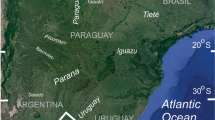Abstract
Hundreds of depressions (pockmarks) were found within a 40 square kilometer area of the sea floor near the head of Penobscot Bay, Maine. These roughly circular depressions range in diameter from 10 to 300 meters and extend as much as 30 meters below the surrounding sea floor. The pockmarks have formed in marine mud of Holocene age, which unconformably overlies glaciomarine deposits.
The presence of shallow interstitial gas in the mud suggests that the pockmarks are related to the excipe of gas from the sediments, although other factors must be involved.
Similar content being viewed by others
References
Harrington PK (1985) Formation of pockmarks by pore-water escape. Geo-Marine Letters 5:193–197
Hogan PJ (1984) Description and possible origin of bathymetric depressions on the upper Arguelo Slope, offshore California. In: Gorsline D (ed) Origins, Transport, and Deposition of Fine-Grained Sediments. Society Economic Paleontologists and Mineralogists Research Conference, San Jose, California, August 6–9, 1984, pp 67–70
Hovland M (1981) Characteristics of pockmarks in the Norwegian Trench. Marine Geology, 39:103–117
Hovland M (1983) Elongated depressions associated with pockmarks in the western slope of the Norwegian Trench. Marine Geology, 51:35–46
Hovland M, Judd AG, King LH (1984) Characteristic features of pockmarks on the North Sea floor and Scotian Shelf. Sedimentology 31:471–480
Hovland M, Judd A, Maisey G (1985) North Sea gas feeds the North Sea fisheries. New Scientist 107:26
Josenhaus HW, King LH, Fader GB (1978) A side-scan sonar mosaic of pockmarks on the Scotian shelf. Canadian Journal Earth Science 15:831–840
King LH, MacLean B (1970) Pockmarks on the Scotian shelf. Geological Society America Bulletin, 81:3141–3148
Knebel HJ (1986) Holocene depositional history of a large glaciated estuary, Penobscot Bay, Maine. Marine Geology 73:215–236
Knebel HJ, Scanlon KM (1985) Sedimentary framework of Penobscot Bay, Maine. Marine Geology 65:305–324
Nelson CH, Thor DR, Sandstrom MW, Kvenvolden KA (1979) Modern biogenic gas-generated craters (seafloor “pockmarks”) on the Bering Shelf, Alaska. Geological Society America Bulletin 90:1144–1152
Newton RS, Cunningham RC, Schubert CE (1980) Mud volcanoes and pockmarks: Seafloor engineering hazards or geological curiosities? Proceedings 12th Offshore Technology Conference. Houston, Texas, #3729:425–429
Ostericher Jr C (1965) Bottom and subbottom investigations of Penobscot Bay, Maine, 1959. U.S. Naval Oceanographic Office Technical Report 173, 177 pp
Platt J (1977) Significance of pockmarks for engineers. Offshore Engineer, August, Letters and Books Section, pp 45
Whiticar MI, Werner F (1981) Pockmarks: submarine vents of natural gas or freshwater seeps? Geo-Marine Letters 1:193–199
Author information
Authors and Affiliations
Rights and permissions
About this article
Cite this article
Scanlon, K.M., Knebel, H.J. Pockmarks in the floor of Penobscot Bay, Maine. Geo-Marine Letters 9, 53–58 (1989). https://doi.org/10.1007/BF02262818
Received:
Revised:
Issue Date:
DOI: https://doi.org/10.1007/BF02262818




